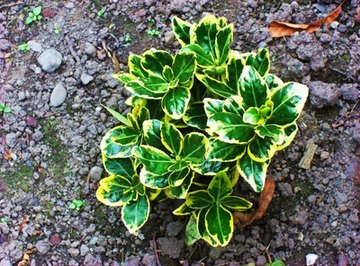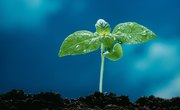
Humans and most other animals need certain things to survive. Oxygen is one of them, and the carbohydrate glucose is another. Fortunately for them, plants (and certain bacteria and algae) produce both of these as the result of a complex process known as photosynthesis.
The Formula
The formula associated with the process of photosynthesis is
6H2O + 6CO2 = C6H12O6 + 6O2.
This formula tells you is that six molecules of water plus six molecules of carbon dioxide will produce one molecule of glucose plus six molecules of oxygen. This entire process goes through two distinct stages before it is completed. The first stage is a light-dependent process and the second stage is a light-independent process.
Light Dependent
In the light-dependent process, the electrons of the chloroplasts (special organelles used to carry out photosynthesis) are excited into a higher energy state when they are bombarded with light. These excited electrons cause a series of reactions that produce adenosine triphosphate (ATP) and nicotinamide adenine dinucleotide phosphate (NADPH). ATP and NADPH are then used to make carbon bonds in the light-independent process. Water molecules present in the light-dependent process are split. Their oxygen molecules are released into the atmosphere.
Light Independent
Recall the splitting of the water molecules in the light-dependent process that released oxygen molecules into the atmosphere. Since water is H20, there is still a hydrogen atom remaining. This hydrogen atom is used in the light-independent process when plants take carbon dioxide from the atmosphere. The carbon dioxide and hydrogen become bound together through a process called carbon fixation, which forms a non-specific carbohydrate.
Photophosphorylation
Photophosphorylation is the process by which light energy produces NADPH. Special pigments found in the plant’s cells known as chlorophyll make this process possible. The two main types of chlorophyll are chlorophyll A and chlorophyll B. In simple terms, the electrons of water molecules present in chlorophyll B become excited by the presence of light. Chlorophyll B takes one of these excited electrons splitting the H2O molecule into H+ and O-2. O-2 is converted into O2 and released into the atmosphere. The excited electron is attached to a primary electron receptor, and through a series of complex reactions forms NADPH. NADPH is the energy carrier used in carbon fixation.
The Calvin Cycle
Plants produce glucose in a process known as the Calvin cycle. The carbon dioxide captured in the light-independent process is processed in this cycle. For every six molecules of carbon dioxide captured and put into the cycle, one molecule of glucose is produced. The chemical that captures the carbon dioxide for use in the Calvin cycle is ribulose biphosphate.
References
- Royal Society of Chemistry: Photosynthesis
- YouTube: Khan Academy - Photosynthesis Calvin Cycle
- YouTube; Khan Academy - 16:58 C-4 Photosynthesis Khan Academy 336K views 21:14 Photosynthesis (updated honors biology) Beverly Biology 53K views 14:37 Photosynthesis: Fun in the Sun ThePenguinProf 115K views 4:54 Science - Amazing Process Of Photosynthesis Designmate Pvt. Ltd. - Official 130K views 15:38 Photosynthesis and Respiration Bozeman Science 711K views 3:09 Learn about photosynthesis learning junction 117K views How to Wake up at 4:30 AM and be Excited - 4 Simple Steps to Wake up Early Primed 4M views Photosynthesis & Respiration pvsciteach 347K views How C3, C4 and CAM Plants Do Photosynthesis BOGObiology 100K views Photosynthesis and the Teeny Tiny Pigment Pancakes Amoeba Sisters 668K views Photosynthesis: Light Reactions and the Calvin Cycle Professor Dave Explains 29K views Introduction to cellular respiration | Cellular respiration | Biology | Khan Academy Khan Academy 2.2M views DNA replication and RNA transcription and translation | Khan Academy Khan Academy 1.3M views Photosynthesis: Comparing C3, C4 and CAM RicochetScience 15K views Overview of glycolysis | Cellular respiration | Biology | Khan Academy Khan Academy 1.8M views Photosynthesis
About the Author
Kelley Boles obtained his B.A. in writing from the University of Central Arkansas in 2005. He has been a freelance writer within his community ever since. His most ambitious project today has been the writing of a comprehensive assembly manual for BBQ smokers manufactured by Royal Oak Enterprises LLC.
Photo Credits
Plant image by Hedgehog from Fotolia.com
